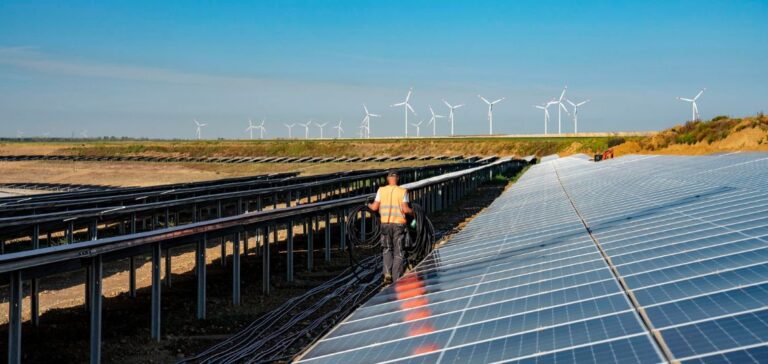Indeland, a solar park of RWE, Germany is a large-scale photovoltaic plant that is now operational.
Conversion of a mine
Indeland is located in the district of Düren in North Rhine-Westphalia. This solar park occupies the territory of the Inden mine, on an area of 15 hectares. In addition to a solar power plant, it has an integrated battery storage.
With this project, RWE will supply part of the solar energy needs of the Inden mine in North Rhine-Westphalia. At the end of mining operations in 2029, the park will be on the lakefront. In addition, RWE is investing 11 million euros in the site.
The solar park consists of approximately 26,500 bifacial solar modules that supply power to 3,500 homes. These modules absorb sunlight at the front and back and allow for optimized power supply through battery storage.
The energy giant installs modules on the site, which are light-sensitive on both sides. These solar modules will produce a peak electrical power of 14.4 MW. They also use the light reflected from the ground behind the modules. This improves the efficiency of the modules.
Two other similar projects
For its part, the storage system is designed for a two-hour charge and power cycle at 9.6 MWh. It thus acts as a buffer between the solar energy production of the photovoltaic farm and the local power grid. Nevertheless, this system can be adapted to better match the variations in demand.
Dr Lars Kulik, CTO Lignite at RWE Power states:
“The RWE Indeland solar park is the visible manifestation of successful structural change and energy transition. The areas previously used for open-cast mining leave plenty of room for renewable energies. We will maintain the Rhine Lignite mining district as an energy production site.”
Katja Wünschel, CEO Onshore Wind and Solar Europe & Australia at RWE Renewables, states:
“With this facility, we are making an important contribution to the energy transition in Germany. And this is just the beginning. We will implement all possible solar and wind projects in our domestic market. In addition, we plan to invest €4 billion in the world of green energy in North Rhine-Westphalia alone.”
By 2030, RWE wants to increase the capacity of its renewable power plant fleet by at least 500 MW in the Rhine mining district.
Two similar plants are under construction at the Garzweiler mine. In this project RWE combines more than 58,340 solar modules with two battery storage systems. As a result, this site will be able to supply 7,250 homes with green energy.
Another installation, combining photovoltaics and storage, should be built around the Hambach mine. The group is thus participating in the German transition. However, RWE is also diversifying its portfolio by securing the transport of CO2 from its power plants, for example.






















